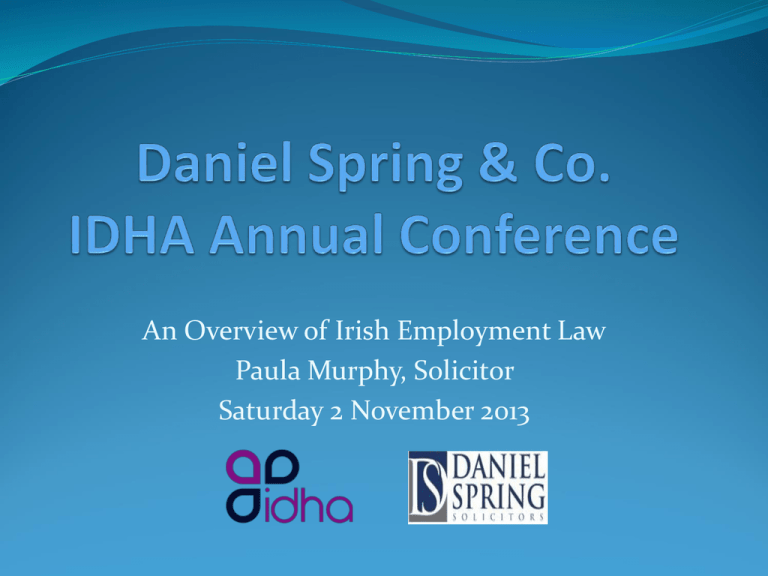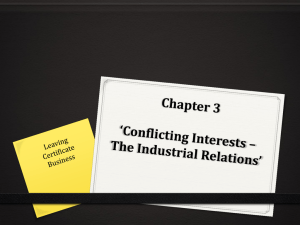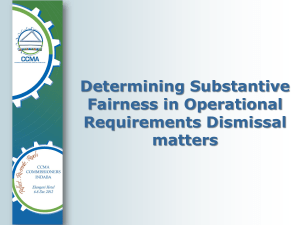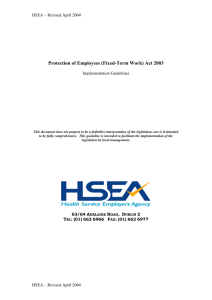13_10_29-Template-Of.. - Irish Dental Hygienists Association
advertisement

An Overview of Irish Employment Law Paula Murphy, Solicitor Saturday 2 November 2013 IRISH DENTAL HYGIENIST ASSOCIATION CONFERENCE 2ND NOVEMBER 2013 EMPLOYEE -vINDEPENDENT CONTRACTOR WHY DOES IT MATTER? Employer vicariously liable for acts of employee Duties implied by common law into the contractual relationship Employee entitlements under statute Employee’s preferential creditors in winding up/receivership Revenue implications for employee/employer HOW DO WE IDENTIFY AN EMPLOYEE? 1. Mutuality of Obligation test 2. Control test 3. Integration test CONTROL TEST “…the fact of the Master’s right to direct the servant not merely as to what is to be done but how it is to be done…” Roche –v- Kelly (1969) Walsh J. INTEGRATION TEST “Under a Contract for Service a man is employed as part of the business, whereas under a Contract for Services his work, although done for the business, is not integrated into it but only accessory to it”. MUTUALITY OF OBLIGATIONS “a continuing obligation on the employer to provide work and pay and a continuing obligation on the employee to do the work provided …” Re Nethermere (St. Noets) Ltd –v- Taverna & Gardiner 1984 IRLR 240 OTHER CONSIDERATIONS Written contract/intention of the parties The Revenue situation Does the worker work for multiple employers? CONTRACT OF EMPLOYMENT Written Intention of the Parties -vPractice on the Ground Henry Denny & Sons (Ireland) Limited –v- Minister for Social Welfare [1998] I. IR 34 Castleisland Cattle Breeding Society –v- Minister for Social and Family Affairs [2004] IESC 40 Byrne –v- Securispeed UD 451/2001 “in determining whether the new contract is one of service or for services the decider must look at how the contract is worked out in practice as mere wording cannot determine its nature”. Geoghan J – Castleisland Cattle Breeding Society Ltd –v- Minister for Social and Family Affairs [2004] IESC 40. REVENUE SITUATIONS? Not conclusive However regard will be had to it particularly if the employee operated in that capacity for a number of years. MULTIPLE EMPLOYERS Ryan –v- Shamrock Marine (Shannon) Ltd (1990) EAT Castleisland Cattle Breeding Society Ltd –v- Minister for Social and Family Affairs [2004] IESC 40. EMPLOYMENT STATUS GROUP REPORT/CODE OR PRACTICE Is there a Mutuality of Obligation? YES Consider: i. Control ii. Title iii. Revenue Situation iv. Ownership of material v. Insurance etc. NO Not an Employee IMPLICATIONS OF BEING AN EMPLOYEE Good or Bad? INDEPENDENT CONTRACTOR Freedom of Association More control over finances At the will of the employer Limited statutory protections EMPLOYEE – RELEVANT EMPLOYMENT STATUTES Terms of Employment (Information) Acts Unfair Dismissals Acts 1977 to 2007 1994 to 2001 Redundancy Payments Acts 1967 to 2007 Employment Equality Acts 1998 to 2007 Protection of Employment Acts 1977 to Payment of Wages Act 1991 Minimum Wage Act 2000 Maternity Protection Acts 1994 to 2004 Adoptive Leave Acts 1995 and 2005 Parental Leave Acts 1998 and 2006 Carer’s Leave Act 2001 Protection of Employees (Part-Time Work) Act 2001 Protection of Employees (Fixed-Term Work) Act 2003 Minimum Notice and Terms of Employment Acts 1973 to 2001 2007 Industrial Relations Act 1946 to 2004 Employees (Provision of Information and Consultation) Act 2006 Transfer of Undertakings Regulations Organisation of Working Time Act 1997 PAYMENT OF WAGES ACT 1991 i. Readily encashable mode of payment ii. Written statements of wages, contributions and deductions iii. Protection against unlawful deduction of wages PROTECTION OF EMPLOYEES (FIXEDTERM WORK) ACT 2003 i. Equal treatment to permanent employees, with respect to conditions of employees ii. Prevents abuse arising from the use of successive fixed term/fixed purpose contracts MINIMUM NOTICE OF TERMS OF EMPLOYMENT ACTS 1973 to 2001 13 weeks to 2 years’ service 1 weeks’ notice 2 to 5 years’ service 2 weeks’ notice 5 to 10 years’ service 4 weeks’ notice 10 to 15 years’ service 6 weeks’ notice 15 or more years’ service 8 weeks’ notice UNFAIR DISMISSALS ACT 1977 TO 2007 (THE “UDA”) Every dismissal is presumed to be unfair Burden of proof is on the employer to prove the dismissal is fair Employee entitlements after 12 months employment (unless one of specified exemptions) DEFENCES UNDER UNFAIR DISMISSALS ACT i. Conduct i. Competency ii. Redundancy iii. Other good reason REMEDIES UNDER UNFAIR DISMISSALS ACT i. Reinstatement ii. Re-engagement iii. Compensation REDUNDANCY PAYMENTS ACTS 1967 TO 2007 i. Compensation for loss of service ii. Minimum statutory amount 2 weeks per year of service PLUS 1 week remuneration iii. €600 standard ceiling for a weekly earning iv. Entitlements arise after 2 years employment “TUPE” i. Protect an employee’s statutory and contractual rights in the event that a business or part of a business is transferred ii. Obligation on employers to inform and consult with employees in the event of a proposed transfer ORGANISATION OF WORKING TIME ACT 1991 Daily rest periods Minimum holiday period Maximum working hours QUESTIONS











